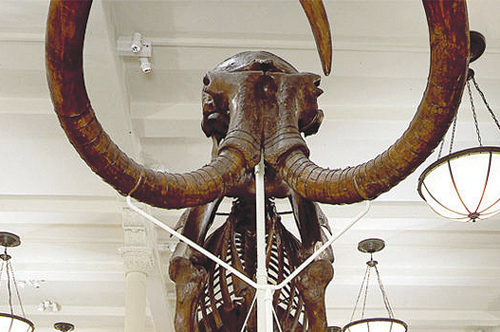Historians cast doubt on Plum Island mammoth report

The Southold Historical Society is disputing the federal government’s claim that woolly mammoth bones were once discovered on Plum Island.
The finding was mentioned in one sentence of the 500-page Final Environmental Impact Statement for the island, released this past October by the General Services Administration.
When questioned by a reporter about the discovery, a GSA spokesperson cited an 1879 article published in The Long Islander newspaper of Huntington as the basis for the claim. The article announced the discovery of a woolly mammoth skull on the island, indicating that it could contain other prehistoric remains dating as far back as the Paleo-Indian era.
But Southold Historical Society director Geoffrey Fleming said several references in the article lead his organization to believe the discovery was made on Plum Island, Mass.
“As soon as we read the [Long Islander] article we realized it wasn’t from here,” he said. “It was very clear from the locations being discussed, like the life saving station, which never existed on Plum Island [New York].”
Mr. Fleming also said a reference to “Brothers Beach” and a captain named in the article further indicate that the article was about the island in Massachusetts, though the piece does not specifically mention the state in which the discovery was made.
The historical society is currently researching Plum Island for a book it plans to release later this year.
Environmental groups pushing for the preservation of Plum Island have said the FEIS is lacking critical information required to assess various potential impacts associated with the property’s anticipated sale, and they’ve called for additional studies.
“Regardless of whether there are woolly mammoth bones on Plum Island you would expect the federal government would want to know what is out there in terms of archeology and biology,” Randy Parsons, policy advisor for The Nature Conservancy of Long Island, told the Suffolk Times earlier this month. “It points to a weakness in the way the island is run by the federal government.”
New York senators Kirsten Gillibrand and Charles Schumer and Congressman Tim Bishop have also joined in pointing out flaws in the environmental study.
The three elected officials outlined eight areas in need of additional study in a letter sent to the GSA last Friday. Soil and groundwater contamination, an inventory of solid waste sites and an assessment of the island’s existing sewage treatment structure were all examples listed in the letter.
“In order to best plan for its future and to prevent a rush to mistakenly move it to an unwise and unwarranted sale, we need a top-to-bottom environmental review of Plum Island, especially in light of the scientific research conducted at Plum Island,” Mr. Schumer said in a prepared statement.
Despite the “outstanding issues” detailed in the letter, the GSA plans to move forward with the sale without any additional testing, according to GSA public affairs officer Patrick Sclafani, who added that a note may still be added to correct the location of the mammoth bone discovery.
“The federal government is required by law to sell Plum Island,” reads a prepared statement from the GSA. “An Environmental Impact Statement prepared over a two-year time frame takes into account hundreds of comments from the public and analyzes the potential impacts of the sale of Plum Island on human health and the environment.GSA and DHS will continue to work closely with EPA, congressional and local officials to ensure all environmental concerns are reviewed and considered.” Once the property is sold, state and local regulatory agencies will have the authority to conduct additional reviews of the island, according to the statement.
The 840-acre island is home to the Plum Island Animal Disease Center, which is expected to be shut down and replaced by a new $1 billion animal disease research facility in Manhattan, Kan. Should the lab close, the GSA hopes to sell the property to a private developer for possible construction of up to 500 homes, according to the FEIS.
Since the island is federally owned, it is not currently subject to local zoning regulations. If it were sold, Southold Town would have jurisdiction over the property, which has prompted local officials to create new zoning categories for the island. The zoning is a precautionary measure aimed at preventing commercial development if the island is sold. It proposes two separate zones reflecting current uses as a research center and considerable open space.
The Southold Town Board is expected vote on the proposed zoning during its meeting Tuesday, Aug. 27.








